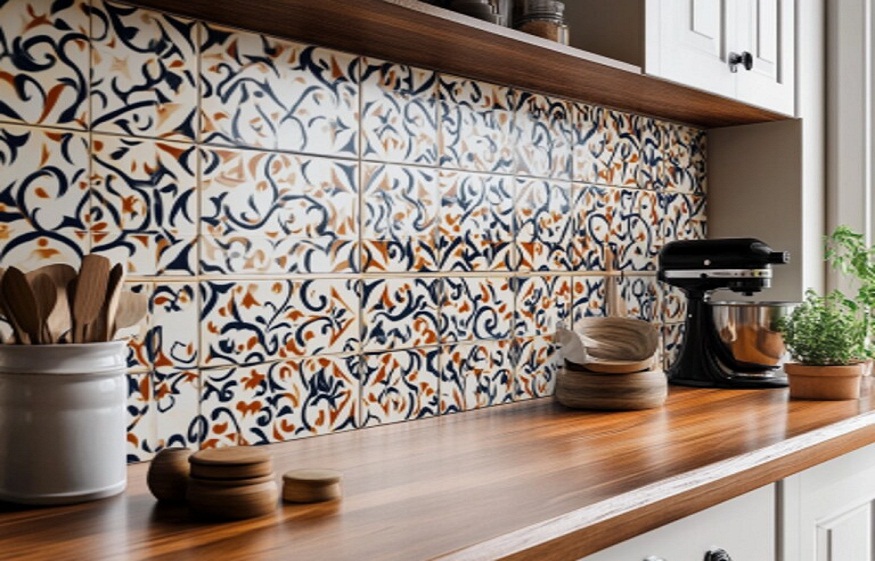When it comes to tiling a home, most people instinctively gravitate towards safe, neutral tones such as whites, greys, and beiges. These colours, while versatile and timeless, are far from the only options available. In 2025, homeowners and interior designers are increasingly exploring unconventional tile colours to add personality and intrigue to kitchens, bathrooms, and beyond. Bold, unexpected hues and unique colour combinations can transform a space into something truly memorable, making tiles not just a backdrop but a statement piece.
The Allure of Deep Emerald and Forest Green
Green tiles are making a significant impact in modern interiors, particularly shades like emerald and forest green. These rich, earthy tones bring a sense of tranquillity and connection to nature, making them an excellent choice for creating a calming atmosphere. Emerald green tiles with a glossy finish can add a luxurious touch to a bathroom, while matte forest green tiles work beautifully in kitchens for a rustic yet modern aesthetic.
Pairing green tiles with metallic accents like brass or gold enhances their depth and elegance. For those who prefer a subtler approach, incorporating green tiles into a backsplash or shower niche offers a striking yet understated focal point.
Muted Mustards for Warmth and Character
Mustard yellow is an unconventional tile colour that’s gaining traction in contemporary design. Its warm, earthy quality makes it a versatile choice for both modern and retro-inspired interiors. Mustard tiles can be used to create a cosy yet bold statement, particularly in kitchens where they pair beautifully with wooden cabinetry and black hardware.
In bathrooms, mustard yellow tiles can add a splash of sunshine, making the space feel inviting and vibrant. To avoid overwhelming the room, using mustard as an accent colour—for example, in a border or feature wall—can provide just the right amount of character without dominating the design.
Dusky Pink for Subtle Sophistication
Pink is no longer relegated to nurseries and ultra-feminine spaces. Dusky, muted pinks have emerged as a sophisticated option for modern tiles, bringing warmth and a touch of romance to interiors. This soft, versatile hue works exceptionally well in bathrooms, where it creates a spa-like ambience when paired with white or light grey tones.
Tiles in dusky pink can also make a bold statement in kitchens, particularly when combined with dark countertops and metallic fixtures. For a contemporary look, consider pairing pink tiles with terrazzo flooring or contrasting them with deep green cabinetry for a striking juxtaposition.
Moody Blues for Drama and Depth
While light blue tiles have been a staple in traditional design, deeper, moodier blues are taking centre stage in 2025. Shades like navy, indigo, and cobalt add drama and sophistication to any space, making them a fantastic choice for feature walls or large-format floor tiles.
In kitchens, dark blue tiles paired with white cabinetry and natural wood accents create a timeless yet contemporary look. In bathrooms, blue tiles can evoke a sense of calm and luxury, especially when combined with gold or brass fixtures. For a more daring approach, using a mix of dark blue shades in a herringbone or chevron pattern can add texture and visual interest.
Terracotta Tones for Earthy Elegance
Terracotta tiles have been used for centuries, but modern iterations of this classic material are bringing it back into the spotlight. Shades like burnt orange, clay, and rust are perfect for creating a warm, earthy atmosphere that feels both grounded and inviting.
Terracotta tiles are especially popular in kitchens and dining areas, where they pair beautifully with natural materials like wood and stone. For a contemporary twist, consider glazed terracotta tiles with a glossy finish, which add a modern edge while retaining their rustic charm. Combining terracotta tones with cool greys or blues can also create a balanced, harmonious palette.
Charcoal and Black for Sleek Sophistication
Black tiles are a bold choice that’s often overlooked due to their dramatic nature. However, when used thoughtfully, they can create a sleek, modern aesthetic that exudes luxury and confidence. Charcoal and matte black tiles are particularly effective in minimalist interiors, where they serve as a striking contrast to lighter elements.
In bathrooms, black tiles can be used to create a moody, spa-like atmosphere, especially when paired with soft lighting and natural materials. In kitchens, black tiles make a strong statement as a backsplash or feature wall, offering a dramatic backdrop for lighter cabinetry and metallic accents.
Soft Lavender and Lilac for a Fresh Take
Lavender and lilac tiles bring a fresh, unexpected touch to modern interiors. These soft, pastel shades are perfect for creating a serene and uplifting atmosphere, particularly in bathrooms and smaller spaces. Lavender tiles with a glossy finish can add a subtle shimmer, enhancing the light in a room and making it feel more spacious.
Pairing these tiles with white or cream accents creates a clean, elegant look, while combining them with darker hues like navy or charcoal adds depth and contrast. For a playful twist, consider mixing lavender tiles with other pastel shades in a mosaic or geometric pattern.
Rich Burgundy and Wine for Opulent Style
Burgundy and wine-coloured tiles are a bold choice that brings a sense of opulence and richness to interiors. These deep, warm hues are perfect for creating a cosy and inviting atmosphere, making them ideal for kitchens and dining spaces.
When used in bathrooms, burgundy tiles can add a luxurious, spa-like feel, especially when paired with gold or brass fixtures. To avoid overwhelming the space, using these tiles as an accent—such as in a shower niche or backsplash—can provide just the right amount of drama and sophistication.
Cool Mint and Sage for Subtle Freshness
Mint and sage green tiles are a refreshing alternative to traditional neutral tones. These soft, cool hues bring a sense of calm and balance to interiors, making them an excellent choice for bathrooms and kitchens alike. Mint tiles with a glossy finish can add a touch of retro charm, while matte sage tiles create a more contemporary look.
Pairing mint or sage tiles with natural materials like wood or stone enhances their organic appeal, creating a harmonious and soothing environment. For a modern twist, consider using these colours in a geometric or patterned design, which adds texture and visual interest.
Metallic Tiles for Modern Glamour
Metallic tiles in shades of gold, silver, and copper are an unconventional choice that adds a touch of glamour and sophistication to any space. These tiles can be used to create striking feature walls or backsplashes, where their reflective surfaces catch and play with light, adding depth and dimension.
Gold tiles, in particular, are ideal for creating a luxurious, high-end look, while silver and pewter tones offer a cooler, more industrial aesthetic. Copper tiles, with their warm, earthy undertones, strike a balance between modernity and rustic charm, making them a versatile choice for both kitchens and bathrooms.
Combining Colours for Unique Designs
One of the most exciting aspects of modern tile design is the ability to combine colours in creative and unexpected ways. Mixing unconventional tile colours can result in stunning, one-of-a-kind designs that reflect your personal style and elevate your interior.
For example, pairing mustard yellow with navy blue creates a bold, dramatic contrast, while combining soft pink with mint green offers a playful, retro-inspired aesthetic. Terracotta and sage green work beautifully together to create an earthy, harmonious palette, while burgundy and gold exude opulence and sophistication.
The Role of Grout in Enhancing Tile Colours
The colour of the grout used with tiles can have a significant impact on the overall design, especially when working with unconventional hues. Contrasting grout colours can highlight the shape and arrangement of tiles, creating a bold, graphic effect. Matching grout, on the other hand, allows the tiles to take centre stage, creating a seamless and cohesive look.
For metallic or high-gloss tiles, neutral or slightly darker grout shades can help balance their reflective qualities. For pastel tiles, white or light grey grout enhances their softness and subtlety, while darker grout adds definition and contrast.
Embracing the Unconventional
In 2025, unconventional tile colours are transforming the way homeowners and interior designers approach kitchen and bathroom design. By stepping away from traditional neutrals and exploring bold, unexpected hues, it’s possible to create spaces that are not only functional but also visually striking and full of character. Whether you choose to incorporate rich emerald greens, moody blues, or playful pastels, the possibilities are endless when it comes to using tiles to make a statement.



